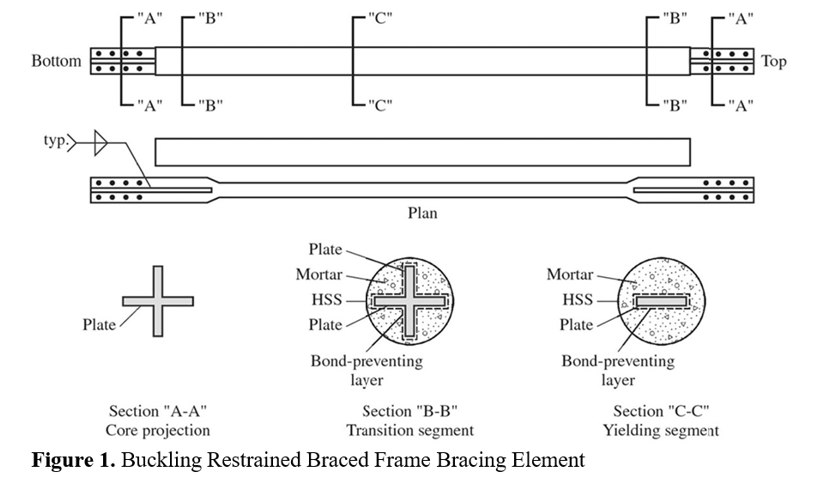
Buckling-Restrained Braced Frames
Buckling-Restrained Braced Frames (BRBFs) are an advanced structural system used in building construction to resist seismic forces. They consist of diagonal steel braces specifically designed to absorb and dissipate seismic energy, reducing the damaging effects of earthquakes on buildings. Unlike traditional steel braced frames, which typically use buckling-prone braces, BRBFs utilize braces that are specifically designed to be buckling-restrained, ensuring their strength and elasticity even under large displacements.
The advantages of BRBFs are:
- Enhanced ductility: BRBFs can withstand substantial deformations during earthquakes while maintaining stability.
- Predictable behavior: BRBFs offer a reliable and predictable response to seismic forces, ensuring the structure performs as intended.
- Improved damage tolerance: The use of buckling-restrained braces minimizes the risk of brace failure and reduces potential structural damage during earthquakes.
- Architectural flexibility: BRBFs provide flexibility in building design, accommodating large open spaces and irregular layouts while providing seismic resistance.
Structural Behavior
BRBFs are designed to undergo controlled yielding and deformation during seismic events, thereby dissipating the energy generated by the earthquake. The diagonal braces in BRBFs are the primary components responsible for resisting lateral forces. These braces are designed to remain within the elastic range and avoid buckling. The energy dissipation occurs through a combination of brace yielding and frictional forces within the brace connections.
Brace Configurations
The braces in BRBFs can be made of steel plates or tubes, depending on the design requirements. Various configurations are used to restrain buckling and enhance performance:
- a) Buckling-Restrained Braces: These braces are designed to prevent buckling under compressive forces. Buckling is typically restrained through the use of restraining elements, such as external collars or internal stiffeners, which limit the lateral deflection of the brace. This allows the brace to maintain its strength and stiffness, even under large deformations.
- b) Unbonded Braces: Unbonded braces consist of a steel core surrounded by a high-friction material, such as grout or rubber. The high-friction material provides restraint against buckling and allows the brace to exhibit significant energy dissipation capacity.
Limitations
- Cost: BRBFs may involve higher material and construction costs compared to other structural systems. The need for specialized brace configurations and additional detailing contributes to the increased cost.
- Maintenance: Regular inspection and maintenance are crucial for ensuring the long-term performance of BRBFs. The connections and brace elements require periodic checks to identify any signs of damage or degradation.
Overall, BRBFs are a reliable and effective solution for seismic resistance in earthquake-prone regions. However, their design and implementation should be carried out by qualified structural engineers with expertise in seismic design.

สำหรับช่องทางการประชาสัมพันธ์กิจกรรมต่าง ๆ และข้อมูลข่าวสาร ความรู้ ในรูปแบบอื่น ๆ ที่เกี่ยวข้องกับ เหล็กเพื่องานก่อสร้าง ของทางบริษัทฯ ยังมี Facebook Page และ Youtube Channel และ Line Officail Account ชื่อ “WeLoveSteelConstruction” นอกจากนี้ทาง บริษัทฯ ยังมีงานสัมมนาประจำปีที่มีเนื้อหาการบรรยายดี ๆ เกี่ยวข้องกับงานก่อสร้างด้วยเหล็ก รายละเอียดสามารถคลิกตามลิ้งค์ข้างล่างได้เลยครับ
#WeLoveSteelConstruction_Facebook